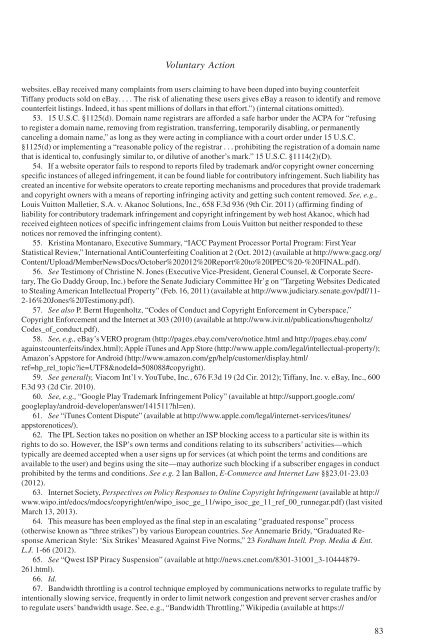1oz61wa
1oz61wa
1oz61wa
You also want an ePaper? Increase the reach of your titles
YUMPU automatically turns print PDFs into web optimized ePapers that Google loves.
Voluntary Action<br />
websites. eBay received many complaints from users claiming to have been duped into buying counterfeit<br />
Tiffany products sold on eBay. . . . The risk of alienating these users gives eBay a reason to identify and remove<br />
counterfeit listings. Indeed, it has spent millions of dollars in that effort.”) (internal citations omitted).<br />
53. 15 U.S.C. §1125(d). Domain name registrars are afforded a safe harbor under the ACPA for “refusing<br />
to register a domain name, removing from registration, transferring, temporarily disabling, or permanently<br />
canceling a domain name,” as long as they were acting in compliance with a court order under 15 U.S.C.<br />
§1125(d) or implementing a “reasonable policy of the registrar . . . prohibiting the registration of a domain name<br />
that is identical to, confusingly similar to, or dilutive of another’s mark.” 15 U.S.C. §1114(2)(D).<br />
54. If a website operator fails to respond to reports filed by trademark and/or copyright owner concerning<br />
specific instances of alleged infringement, it can be found liable for contributory infringement. Such liability has<br />
created an incentive for website operators to create reporting mechanisms and procedures that provide trademark<br />
and copyright owners with a means of reporting infringing activity and getting such content removed. See, e.g.,<br />
Louis Vuitton Malletier, S.A. v. Akanoc Solutions, Inc., 658 F.3d 936 (9th Cir. 2011) (affirming finding of<br />
liability for contributory trademark infringement and copyright infringement by web host Akanoc, which had<br />
received eighteen notices of specific infringement claims from Louis Vuitton but neither responded to these<br />
notices nor removed the infringing content).<br />
55. Kristina Montanaro, Executive Summary, “IACC Payment Processor Portal Program: First Year<br />
Statistical Review,” International AntiCounterfeiting Coalition at 2 (Oct. 2012) (available at http://www.gacg.org/<br />
Content/Upload/MemberNewsDocs/October%202012%20Report%20to%20IPEC%20-%20FINAL.pdf).<br />
56. See Testimony of Christine N. Jones (Executive Vice-President, General Counsel, & Corporate Secretary,<br />
The Go Daddy Group, Inc.) before the Senate Judiciary Committee Hr’g on “Targeting Websites Dedicated<br />
to Stealing American Intellectual Property” (Feb. 16, 2011) (available at http://www.judiciary.senate.gov/pdf/11-<br />
2-16%20Jones%20Testimony.pdf).<br />
57. See also P. Bernt Hugenholtz, “Codes of Conduct and Copyright Enforcement in Cyberspace,”<br />
Copyright Enforcement and the Internet at 303 (2010) (available at http://www.ivir.nl/publications/hugenholtz/<br />
Codes_of_conduct.pdf).<br />
58. See, e.g., eBay’s VERO program (http://pages.ebay.com/vero/notice.html and http://pages.ebay.com/<br />
againstcounterfeits/index.html); Apple iTunes and App Store (http://www.apple.com/legal/intellectual-property/);<br />
Amazon’s Appstore for Android (http://www.amazon.com/gp/help/customer/display.html/<br />
ref=hp_rel_topic?ie=UTF8&nodeId=508088#copyright).<br />
59. See generally, Viacom Int’l v. YouTube, Inc., 676 F.3d 19 (2d Cir. 2012); Tiffany, Inc. v. eBay, Inc., 600<br />
F.3d 93 (2d Cir. 2010).<br />
60. See, e.g., “Google Play Trademark Infringement Policy” (available at http://support.google.com/<br />
googleplay/android-developer/answer/141511?hl=en).<br />
61. See “iTunes Content Dispute” (available at http://www.apple.com/legal/internet-services/itunes/<br />
appstorenotices/).<br />
62. The IPL Section takes no position on whether an ISP blocking access to a particular site is within its<br />
rights to do so. However, the ISP’s own terms and conditions relating to its subscribers’ activities—which<br />
typically are deemed accepted when a user signs up for services (at which point the terms and conditions are<br />
available to the user) and begins using the site—may authorize such blocking if a subscriber engages in conduct<br />
prohibited by the terms and conditions. See e.g. 2 Ian Ballon, E-Commerce and Internet Law §§23.01-23.03<br />
(2012).<br />
63. Internet Society, Perspectives on Policy Responses to Online Copyright Infringement (available at http://<br />
www.wipo.int/edocs/mdocs/copyright/en/wipo_isoc_ge_11/wipo_isoc_ge_11_ref_00_runnegar.pdf) (last visited<br />
March 13, 2013).<br />
64. This measure has been employed as the final step in an escalating “graduated response” process<br />
(otherwise known as “three strikes”) by various European countries. See Annemarie Bridy, “Graduated Response<br />
American Style: ‘Six Strikes’ Measured Against Five Norms,” 23 Fordham Intell. Prop. Media & Ent.<br />
L.J. 1-66 (2012).<br />
65. See “Qwest ISP Piracy Suspension” (available at http://news.cnet.com/8301-31001_3-10444879-<br />
261.html).<br />
66. Id.<br />
67. Bandwidth throttling is a control technique employed by communications networks to regulate traffic by<br />
intentionally slowing service, frequently in order to limit network congestion and prevent server crashes and/or<br />
to regulate users’ bandwidth usage. See, e.g., “Bandwidth Throttling,” Wikipedia (available at https://<br />
83


